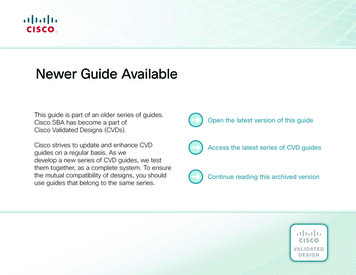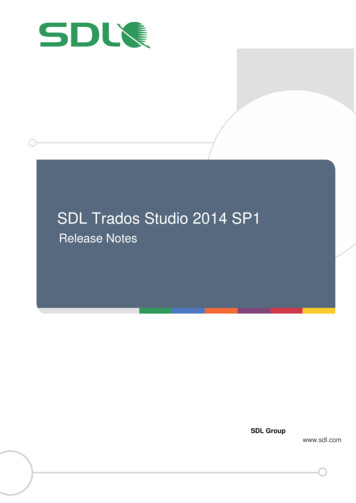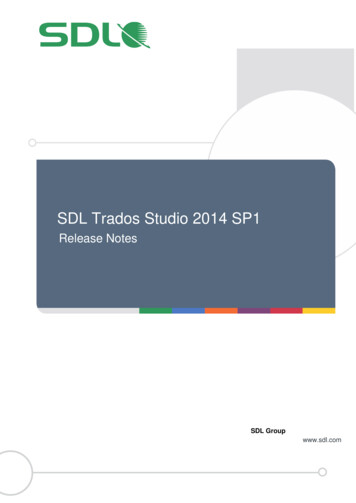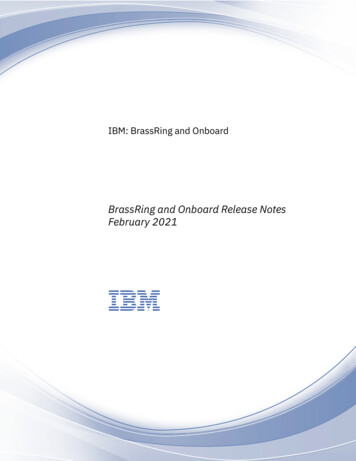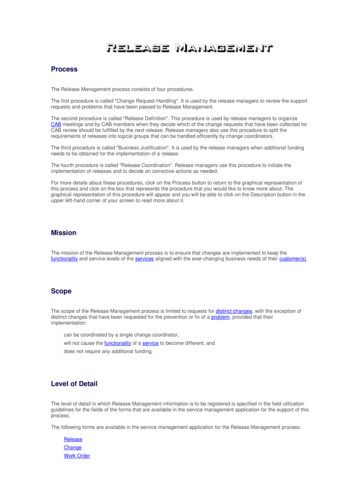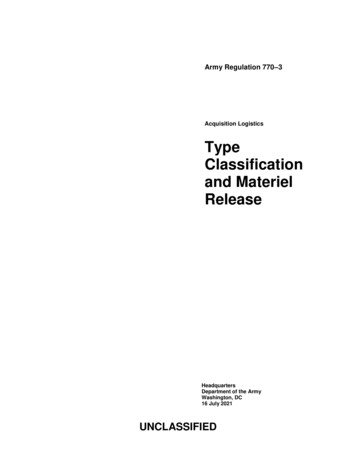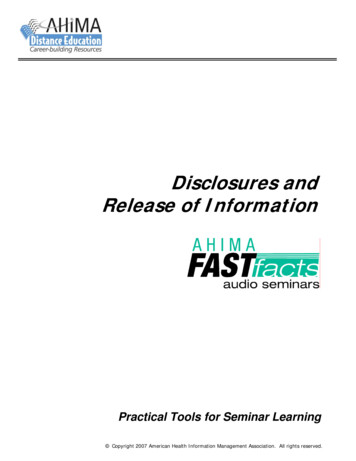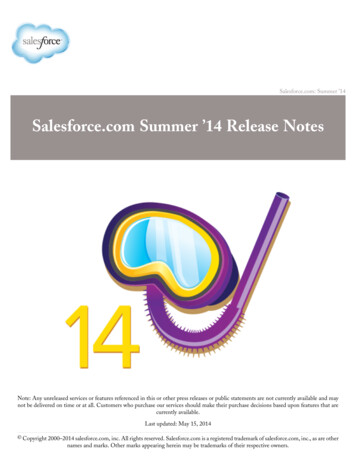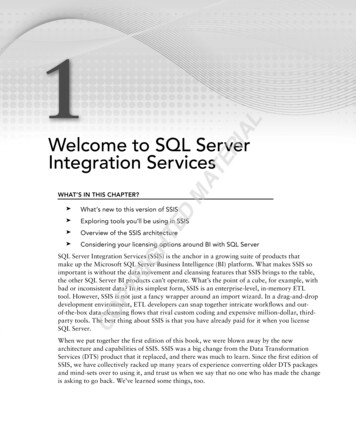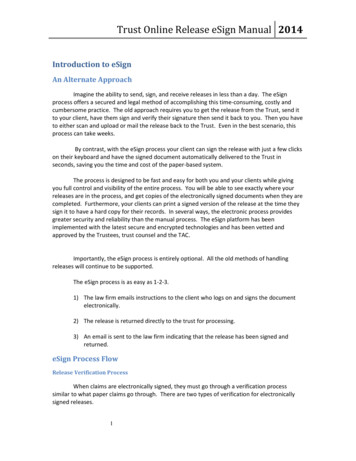
Transcription
TrustOnline Re le a se e Sig nM a nua l 2014Introd uc tion to e Sig nAn Alte rna te Approa c hImagine the ability to send, sign, and receive releases in less than a day. The eSignprocess offers a secured and legal method of accomplishing this time-consuming, costly andcumbersome practice. The old approach requires you to get the release from the Trust, send itto your client, have them sign and verify their signature then send it back to you. Then you haveto either scan and upload or mail the release back to the Trust. Even in the best scenario, thisprocess can take weeks.By contrast, with the eSign process your client can sign the release with just a few clickson their keyboard and have the signed document automatically delivered to the Trust inseconds, saving you the time and cost of the paper-based system.The process is designed to be fast and easy for both you and your clients while givingyou full control and visibility of the entire process. You will be able to see exactly where yourreleases are in the process, and get copies of the electronically signed documents when they arecompleted. Furthermore, your clients can print a signed version of the release at the time theysign it to have a hard copy for their records. In several ways, the electronic process providesgreater security and reliability than the manual process. The eSign platform has beenimplemented with the latest secure and encrypted technologies and has been vetted andapproved by the Trustees, trust counsel and the TAC.Importantly, the eSign process is entirely optional. All the old methods of handlingreleases will continue to be supported.The eSign process is as easy as 1-2-3.1) The law firm emails instructions to the client who logs on and signs the documentelectronically.2) The release is returned directly to the trust for processing.3) An email is sent to the law firm indicating that the release has been signed andreturned.e Sig n Proc e ssFlowRe le a se Ve rific a tion Proc e ssWhen claims are electronically signed, they must go through a verification processsimilar to what paper claims go through. There are two types of verification for electronicallysigned releases.1
TrustOnline Re le a se e Sig nM a nua l 2014The Automated process applies to claims where the injured party is living and does nothave a power of attorney or personal representative who will sign the release. In theseinstances, after the injured party electronically signs the release, it is automatically verified bythe system, and the claim is sent to the payment queue.The Manual process applies to claims where the injured party is either deceased orliving and has a power of attorney or personal representative who signed the release for them.In these instances when the P.O.A. or P.R. electronically signs the release, the release is notautomatically verified and the claim is sent to the release verified queue for manual verification.Le g a l– Fe d e ra la nd Sta te Le g isla tionESIGN – Federal law approving use of electronic signatures: The Electronic Signature inGlobal and National Commerce Act (ESIGN, Pub.L. 106-229, 14 Stat. 464, enacted June 30, 2000,15 U.S.C. ch. 96) is a United States federal law passed by the U.S. Congress to facilitate the useof electronic records and electronic signatures in interstate and foreign commerce by ensuringthe validity and legal effect of contracts entered into electronically. The general intent of theESIGN Act is spelled out in the very first section (101.a), that a contract or signature “may not bedenied legal effect, validity, or enforceability solely because it is in electronic form”. This simplestatement provides that electronic signatures and records are just as good as their paperequivalents, and therefore subject to the same legal scrutiny of authenticity that applies topaper documents.UETA – State-by-state laws that further clarify and approve use of electronic signaturesat the state level: The Uniform Electronic Transactions Act (UETA) is one of the several UnitedStates Uniform Acts proposed by the National Conference of Commissioners on Uniform StateLaws (NCCUSL). Since then 47 states, the District of Columbia, Puerto Rico and the U.S. VirginIslands have adopted it into their own laws. Its overarching purpose is to bring into line thediffering State laws over such areas as retention of paper records (checks in particular), and thevalidity of electronic signatures, thereby supporting the validity of electronic contracts as aviable medium of agreement.Se c urityThe electronic signature process has enhanced security over the conventional papermethod. With the paper method, it is very difficult to know if the document provided to theclaimant is exactly what was issued by the Facility. Furthermore, it is similarly difficult to knowthat the document returned to the Facility is the same as what the claimant signed. There is noway to know whether or not a document has been digitally altered.With the electronic method, the release document is provided directly to the claimantelectronically and there is no opportunity for it to be tampered with or otherwise modified.Once the release is signed, it is digitally encrypted making the document tamper proof. Everyelectronic touch of the document is logged providing a full audit trail and chain of custody;therefore, the Trust, the law firm and the claimant can independently verify that the documenthas not been altered after being signed.2
TrustOnline Re le a se e Sig nM a nua l 2014The IP address of the computer used to sign the document is compared against adatabase of all Trust Online user IP addresses. When a release is signed from a computer thatmight not typically be used by a claimant, the trust will follow up with the law firm to guardagainst inappropriate use of the eSignature process.Re le a se M a na g e m e ntIn order to provide law firms with an efficient way to manage the electronic signatureprocess, a new tab in the Notifications page of Trust Online has been added. In the process ofadding this new feature, it became clear that this functionality is useful for all releasemanagement, not just those designated for electronic signature. We would encourage you toconsider using this new feature for all your release management tasks, whether or not youchoose to take advantage of eSign.In addition to this new tab, we have added a Trust filter to the existing Notificationsection. This new feature will help law firms manage the huge inventory of notificationsgenerated by Trust Online.The Release Management section allows firms to search for their releases in a numberof different ways. Similar to the Claim Search page, firms can still search for their releases byClaim Number, Last Name, Social Security Number, Firm File Number, Confirmed Injury, ClaimOption, Status and Queue. In addition to these search criteria, firms may also search by any ofthe Release specific filters listed below.3
TrustOnline Re le a se e Sig nM a nua l 2014 Release Issue Date – Users can search for releases within a date range. The ReleaseIssue Date would be the date the release was created. Releases issued on the From orTo date will be included in the search results.eSign Status – Users can search for releases that have been electronically signed bychecking the Signed box or ones that have not been electronically signed by checkingthe Unsigned box. If none or both boxes are checked, all signed and unsigned releaseswill be included in the search results.Selected for eSign– Users can search for releases that were selected for the eSignatureprocess by checking this box.eSign Signature Date – Users can search for releases within a date range. The eSignSignature Date would be the date the release was electronically signed by the client.Releases signed on the From or To date will be included in the search results.Comment – Users can search for releases with comments that were previously enteredby a user.The releases returned in the search results include information pertaining to the specificrelease. Only claims that have an active release (not cancelled) will be included in the results.Depending upon the Results View selected, more or less information will be available.The Standard results view includes the Name, SSN, Attorney, Confirmed Injury, Claim #,Option, Release Issue Date, Gross Value, Offset, Liquidated Value, eSign Key, Comment, andeSign Selected.The Extended results view includes the same information as the Standard results view aswell as the following information: Trust, Status, Queue, Firm File #, eSign Status, eSign SignatureDate and Edited By.EDITABLE FIELDSStandard Results ViewA key feature of the release results grid is the ability to edit each record that is returned.The editable fields, the Comment and eSign Selected fields, allow firms to make commentsspecific to the release while the eSign Selected field is a check box that enables the firm to keeptrack of the releases they have selected for the eSign process.In the example above, the eSign Selected field is set to “Yes” which indicates that thefirm has marked this record in order to have it electronically signed by their client. They alsoadded a comment stating “send to claimant for signature”. Also notice that the eSign Statusfield which indicates whether or not a release has been electronically signed defaults to“Unsigned” until the time the release is eSigned.After the claimant electronically signs the release, the eSign Status is updated to reflectthe new Signed status and the Queue has changed from the Offer Issued Tank to the ReleaseVerify Queue.4
TrustOnline Re le a se e Sig nM a nua l 2014Extended Resultse Sig n Proc e ssThe Release Management page is intended for searching, tracking and managingreleases in various stages of the release life cycle from the time they were issued through thepayment process. With the added ability to export all of these records to an Excel spreadsheetand email your clients this information using mail merge, firms can easily manage the eSignprocess while maintaining total privacy and complete control over the communication with theirclients. It is impossible for the Trust to see, track or in any way be involved in thecommunication between you and your clients.ExportingThe new Release Management page has advanced search capabilities using releasespecific criteria to narrow your search. Once you decide which releases need to be emailed toyour clients for electronic signature, you can search for this list of claims and export them to anExcel file by clicking on the Save to File link. A File Download dialogue box prompting the userto Open or Save the file will be displayed. The file will be saved as a comma separated value(.csv) file. Once it is saved, you can re-open and save the file as an Excel file format and add anyadditional column with the data needed to email your clients using the Mail Merge feature inthe Microsoft Office Suites.M a ilM e rg eUsing Excel, Word and Outlook, you can easily create a mail merge document to emailyour clients with all of the vital information needed to have the releases electronically signed.For example, you can create a Word document template with instructions on how to sign therelease electronically, the claim number, the eSign Key as well as the link to the eSign site. Ifyou have questions about how to create and use a mail merge document, please contact WebSupport at the Facility.e Sig na ture Re le a se Notific a tionsAn email notification is sent to firms each day notifying them of which clientselectronically signed releases. To receive the email notifications, either the firm super user orthe attorney, who must have a Trust Online attorney account, can set up users to receive theeSignature Release Notifications by going to their Profile page and setting the preferences foreach user.5
TrustOnline Re le a se e Sig nM a nua l 2014SAVEThe notification has to be set up for each Trust the user has access to, or if the userwants to be notified for all trusts, you can leave the default of “All” and select the user(s) fromthe Account drop-down box. After adding the user, click the Disk icon to save the new addedline. After adding each of the users click the Save button at the bottom of the page in orderfor all changes to take effect.H ow to sig n yourre le a se e le c tronic a lly– Cla im a ntInstruc tionsFirst, click on the link sent in the email from your attorney. Clicking on this link willdirect you to the login page of the Offer Acceptance and Release Signature site. Also in thisemail, the attorney has provided you with the Claim Number and eSign Key. These two pieces ofinformation as well as the injured party’s date of birth and the last 4 digits of the social securitynumber are needed to log into the site.After entering these 4 pieces of information, click the Sign In button. After logginginto the site, you will be able to view the summary claim information, a copy of the release andtwo buttons – a Sign Later and Sign. The summary includes the Injured Party, PersonalRepresentative and Release information.Note: There is also an option to print the release and signed it manually. To print therelease, click on the Print Icon located on the PDF reader menu.After pressing the Sign button, you are directed to the signature page itself. In order to “sign”the release, all you have to do is type your name into the text field exactly as it appears belowthat box. Once that is done, simply click the Sign button and you are done.6
TrustOnline Re le a se e Sig nM a nua l 2014PRINTICONOnce the release is successfully eSigned, a confirmation message will appear stating the releasehas been sent to the Facility for processing.The release will continue to be available to view or print for 30 days from the date the releasewas signed. As noted on the website, if you have any issues or questions please contact yourattorney.7
TrustOnline Release eSig nManual 2014 4 Release Issue Date - Users can search for releases within a date range. The Release Issue Date would be the date the release was created. Releases issued on the From or To date will be included in the search results. eSign Status - Users can search for releases that have been electronically signed by checking the Signed box or ones that have not been .


